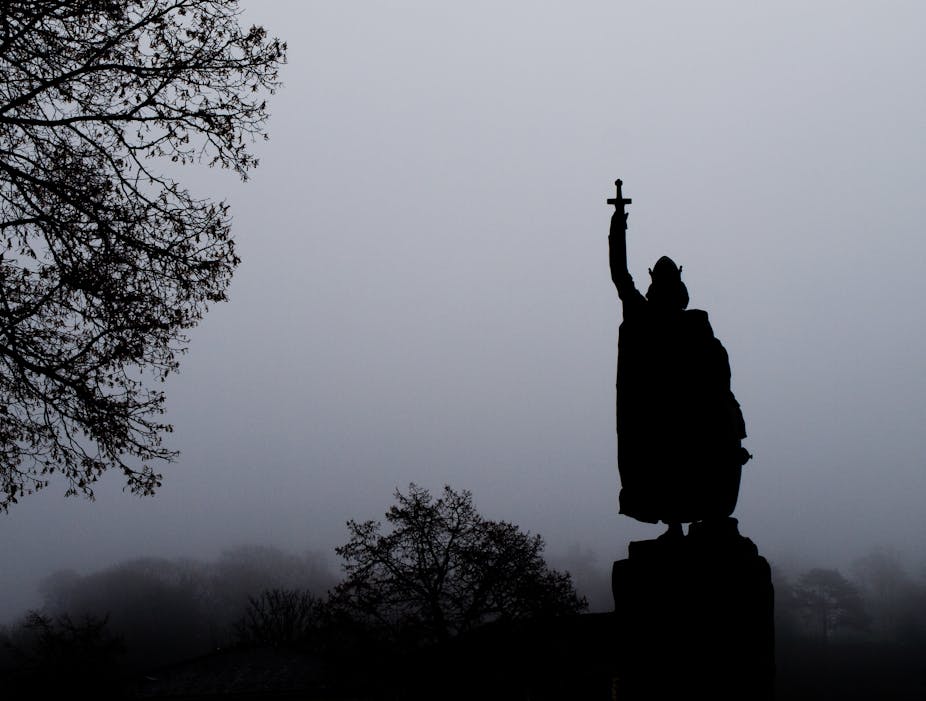After months of research, excavating old graves and following one lead after another, my colleagues and I can confirm that remains we discovered are those of English king Alfred the Great or his son Edward the Elder.
Alfred the Great, King of Wessex in the late 9th century, was a great military leader, law-maker and educationalist. He defeated the invading Vikings and set up military, financial and educational structures, ground-breaking in their sophistication. Upon his death in 899 AD, he was first buried in the Old Minster in Winchester and was subsequently moved, first to the New Minster and then, upon its foundation in 1110, to Hyde Abbey on the northern outskirts of the city along with other members of his family.
The abbey was dissolved by Henry VIII in 1538 but the graves of Alfred the Great, his wife and son, remained largely undisturbed until the site was chosen for the building of a prison in 1788. When prisoners discovered the three lead-lined stone coffins at the site of the high altar, they were broken up, the lead sold and the bones scattered. The site was re-excavated by self-styled romantic antiquarian John Mellor in 1866 and he was convinced that he had rediscovered the bones of Alfred and his family. Mellor sold the remains for ten shillings to the Vicar of Hyde, who had them reburied in a brick-lined vault outside St Bartholomew’s church in Hyde, Winchester.
The process of identifying the remains of the Alfredian royal family was long and meandering. It also wasn’t the outcome I had expected when, on a freezing cold day in March 2013, colleagues and I opened the unmarked grave outside St Bartholomew’s church with the task of exhuming and analysing the remains of the individuals within.
Inside were the remains of six individuals with five skulls, the same skulls that had been photographed in the 19th century before their re-interment. Could these really be the remains of Alfred, his wife Aelswitha and son Edward the Elder, along with other members of the Royal House of Wessex? The individuals included an adult female and three adult males, along with two other very incomplete individuals who may also have been male. There was also evidence for some unusual diseases among the individuals, including conditions that lead to fusion of the spine and restricted movement, and a condition that may have been the result of a long-standing gut or lung disease.
It was a small collection of remains, but very interesting nonetheless. The radiocarbon analysis produced dates in the 12th to 15th centuries. Alfred died in 899 and his son, Edward, in 924, so the conclusion was that these remains could not possibly be members of the Wessex royal family.
This could have been the end of the story. But I knew that a community excavation had taken place at the site of Hyde Abbey church in the 1990s and they had found part of a pelvis dated to the 18th century. It seemed unlikely that this was the only piece of human bone found, so I contacted the museum to find out more. To my surprise, I was told that they had two boxes of human bone that had only been identified some time after the end of the excavation, when no more research could be funded.
A small proportion of this came from the high altar and its immediate surroundings and these were singled out for further analysis and radiocarbon dating. All but one of the samples returned dates in the 12th to 15th centuries, the same range as had been obtained from the remains from the Unmarked Grave. But there was one piece of bone – part of the pelvis of an older adult male – that came back with a date of 895-1017. Even the upper date for this fragment was almost 100 years before the founding of the abbey.
The archaeological and documentary evidence indicated there had been no burials on the site before the abbey was built and therefore the most likely conclusion was that this piece of bone belonged to one of the members of the Royal House of Wessex. The three possible candidates were Alfred, Edward and one of Edward’s brothers, Aethelweard.
Aethelweard can be discounted as his body was not known to have been buried at the site of the high altar. The piece of pelvis is therefore most likely to belong to Edward the Elder or Alfred the Great. So, ten months down the line from our initial excavation, after disappointment and some unexpected twists and turns, we have been able to announce that we may have found part of the remains of an important Saxon king, thought lost for hundreds of years.

